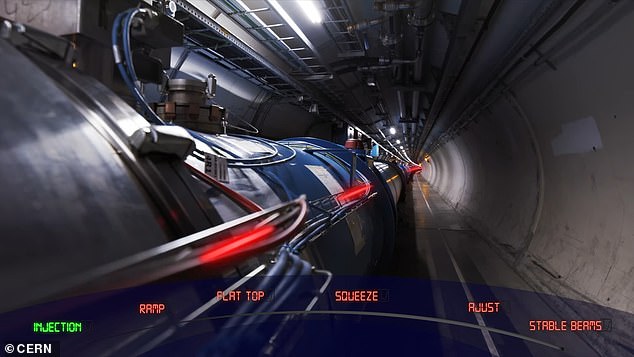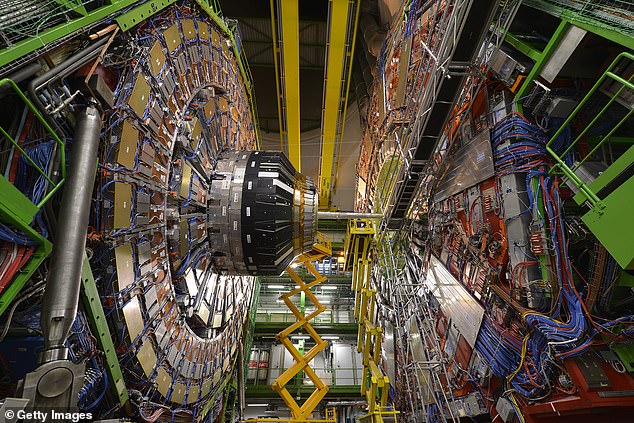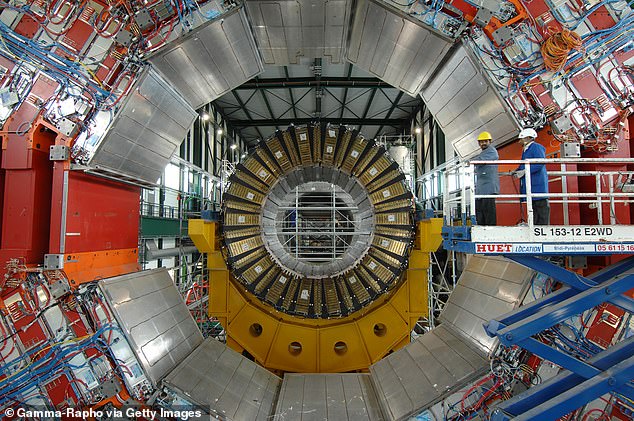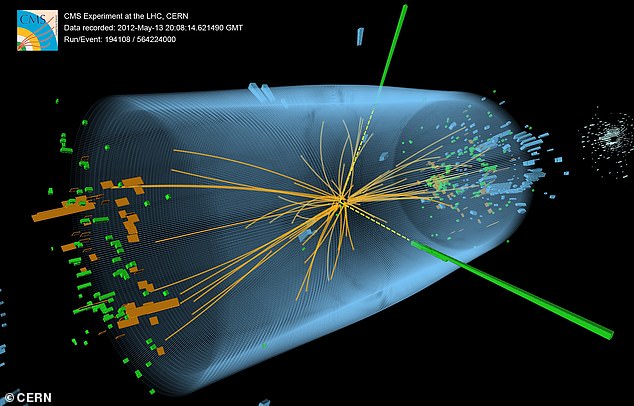The world’s largest and most powerful particle accelerator smashed protons together on Friday, bringing scientists closer to understanding the Big Bang.
CERN researchers put three beams of protons into the Large Hadron Collider (LHC), shooting them down a 17-mile-long tunnel at nearly the speed of light to recreate what happened 13.8 billion years ago.
The LHC smashed the particles together at unprecedented energy to try to blast into existence massive new particles that are secretly powering our universe.
LHC is set to keep the beams moving until Monday, when the team will capture the energy for an analysis – and more collision testing is planned until October.
Arnaud Marsollier, head of media at CERN, told DailyMail.com: ‘This is definitely exciting, I can tell you that scientists are in the starting blocks to receive their wave of data for this year and improve our understanding of nature.
‘We can’t wait to be looking at the Higgs boson in more detail and further search for dark matter with our Big Bang machine!’

The world’s largest and most powerful particle accelerator smashed protons together on Friday, bringing scientists closer to understanding the Big Bang
The CERN team began preliminary tests last month by sending billions of protons around the LHC’s ring of superconducting magnets to boost their energy and ensure the $4 billion machine was in working condition.
The accelerator sits 300 feet underground at the border of France and Switzerland and first went live on September 10, 2008.
The LHC works by smashing protons together to break them apart and discover the subatomic particles that exist inside them, and how they interact – scientists use protons due to them being heavier particles.
The weight allows much lower energy loss per turn through the accelerator than other particles like photon.
‘What we do at CERN is doing particle physics with accelerators such as the LHC, and this has little to do with astrophysics directly, though particle physics and astrophysics can address similar key questions with different approaches and instruments, for example in the research of dark matter, one of the most fascinating mysteries for science,’ said Marsollier.
The LHC goes into hibernation during the winter months each year, then kicks back on the following spring – and that happened on March 8.

CERN researchers put three beams of protons into the Large Hadron Collider (LHC), shooting them down a 17-mile-long tunnel at nearly the speed of light to recreate what happened 13.8 billion years ago

The LHC works by smashing protons together to break them apart and discover the subatomic particles that exist inside them, and how they interact – scientists use protons due to them being heavier particles.
‘Restarting such an accelerator requires a full commissioning process in order to check that all equipment works properly, Marsollier explained..
‘Now, that all the checks have been performed, the LHC is ready to provide particle collisions to the LHC experiments.’
The restart saw beams the beams circle inside the ring of the LHC, allows for more time to accelerate the beam of particles so higher energy can be reached.
Scientists watched in wonder as the beam circled the accelerator in less than 20 minutes, which proved the accelerator was ready for Friday’s exciting event that sent the particles race around ring 11,245 times a second.
Approximately three bunches of beams were injected into LHC today and the energy of the protons was increased to different levels over a few minutes.
The goal was to reach 6.8 teraelectronvolts (TeV) – one TeV is about the same energy released from a flying mosquito – a record that has never been reached in a particle accelerator.
While that may seem like a very small amount of energy, for a single proton it is an incredible amount of energy.
The speed was just seven miles per hour less than the speed of light.
CERN researchers were set to collide particles on the day of the solar eclipse, April 8, but instead pushed the experiment up.

Approximately three bunches of beams were injected into LHC today and the energy of the protons was increased to different levels over a few minutes

The LHC works by smashing protons together to break them apart and discover the subatomic particles that exist inside them, and how they interact – scientists use protons due to them being heavier particles
And Friday they saw the first stable beams – the goal set by CERN.
‘In order to achieve stable beams, the circulating beams must then be ‘squeezed’ and adjusted using the LHC magnets,’ researchers shared in the announcement.
‘This involves making the beams narrower and more centered on their paths, and therefore more likely to produce a high number of collisions in the detectors.
‘Only after the squeezing and adjustment has been completed can stable beams be declared and the experiments around the LHC begin their data taking.’
Approximately three bunches of beams were injected into LHC on Friday and the energy of the protons was increased to different levels over a few minutes.
The goal was to reach 6.8 teraelectronvolts (TeV) – one TeV is about the same energy released from a flying mosquito – a record that has never been reached in a particle accelerator.
While that may seem like a very small amount of energy, for a single proton it is an incredible amount of energy.
‘The ‘Dump on Monday’ means that if everything goes well, the team of operators will keep the beams up and running the whole weekend, and dump it early on Monda, said Marsollier.
‘When we have beams, we try to keep them as long as useful if the quality of collisions and data is good.
‘Then access means they will take the opportunity to go and fix something before the next fill – that’s standard process, we need accesses on a regular basis. ‘
The purpose of LHC is to let scientists test predictions of different particle physics, including measuring the properties of the Higgs boson or God particle, which was a missing piece in trying to understand how the universe works.
Scientists believe that a fraction of a second after the Big Bang that gave birth to the universe, an invisible energy field, called the Higgs field, formed.
As particles passed through the field, they picked up mass, giving them size and shape and allowing them to form the atoms that makeup you, everything around you and everything in the universe.
This was the theory proposed in 1964 by former grammar school boy Professor Higgs that has now been confirmed.
And while the particles nearly instantly decayed during the LHC experiment, scientists found they left a footprint behind revealing their existence.









